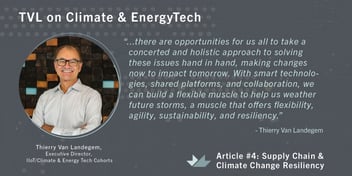Why is it that so many feel the path to net-zero is like putting a destination in your GPS and not knowing what the route is? Making climate solutions more clear-cut and accessible is becoming increasingly important.
Research firm Rhodium Group1 reported that U.S. greenhouse gas emissions rose by 6.2% in 2021 compared to 2020. A Boston Consulting Group2 analysis shows the world can get 70% of the way to net-zero using existing technologies, but 30% of the needed technology “is yet to be invented.” Bill Gates, the driving force behind Breakthrough Energy3 formulates it as follows: “My basic optimism about climate change comes from my belief in innovation. The conditions have never been more clear for backing energy breakthroughs. It’s our power to invent that makes me hopeful.”
In this article, I will focus on rethinking the product design process using sustainability principles, on collaboration between key stakeholders to move faster and further, and the role of startups.
Design for Sustainability
We continue to underestimate the potential of innovation because we continue to do things the way we are used to – if it works, we don’t touch it. However, a big part of the change towards net-zero will come from redesigning today’s products and processes through new technologies and introducing new business models.
Working in the hardtech space, we know there is a huge difference in designing a prototype and a product for volume production. Designing the prototype is all about validating the technology that implements the solution to a problem. Once customer-validated, the design moves towards architectures that focus on cost and volume production – we call it design for manufacturability (DFM). Most products currently in circulation in the world weren’t originally designed with circularity in mind, let alone end-of-life considerations. Just think about batteries, solar panels, and wind turbine blades ending in landfills.
Design for Sustainability4 also takes into account environmental aspects – the choice of materials (using low footprint or recyclables), the impact of production (e.g., using renewable energy), and the impact of the operation of the product on the environment (e.g., energy efficient designs). Current new product innovation not only focuses on cost but also takes into account environmental impact.
The danger, however, is to shift emissions from the operation of the product to its production. A great example is the transition from internal combustion engines to electric propulsion of passenger vehicles (described in a McKinsey study5). The study found that about 20% of the carbon generated by a diesel vehicle comes from its production, with most of the remaining 80% emitted at the tailpipe. An equivalent electric car produced fewer emissions in the use phase but required additional carbon-intensive materials in the battery. If electricity for the vehicle came from fossil fuels, production’s share of lifetime emissions would rise to 45%. If the vehicle were charged using only renewable energy, production emissions would account for 85% of the total.
Renewable energy sources, such as solar and wind, are great examples with a great difference between production and operation footprint. An investigative report about what happens to solar panels6 when ready to retire shows that panel disassembly and recovery of components — from glass to the various precious metals – is a complicated process. Most end up in landfills. We face a similar challenge with the fate of massive wind turbine blades7 when these are removed from their towering stems.
Collaboration among stakeholders
In addition to design for sustainability, the road to net-zero will be one of collaboration, where all stakeholders work together to change the system. Research by BCG on sustainable business model8 innovations shows that companies on their own frequently run into constraints within the wider system. That limits their ability to achieve greater environmental benefits in a way that is economically or operationally feasible for the business. Sustainability partnerships or corporate-led sustainability alliances are the way to go.
Confidence will drive collaboration. Governments and corporations need to provide credible step-by-step plans to reach their net zero goals, build confidence among investors, industry, citizens and other countries. The Global Commons Alliance (GCA) is a network of organizations working together to ensure that societies and the global economy thrive, sustained by healthy global commons, on a stable planet. Breakthrough Energy Catalyst is another exciting example. This coalition of businesses, governments, philanthropies, and individuals will accelerate next-generation climate technologies through direct investments aimed at funding the early deployment of decarbonization technologies. The initial focus is on green hydrogen, long duration energy storage, direct air capture, and sustainable aviation fuel – technologies essential to supporting a net-zero economy.
Startups driving innovation
Startups have an important role to play shaping and shaking stakeholders on the journey towards net-zero. Recently Larry Fink, CEO of Blackrock9, stated that the next 1,000 unicorns won’t be search engines or social media companies. They’ll be sustainable, scalable innovators – startups that help the world decarbonize and make the energy transition affordable for all consumers.
I like an analogy made by Energy Impact Partners – there are plenty of opportunities for innovators and entrepreneurs in the broader climate space. Either you create a wave because you spotted a trend, saw a disruption and built the opportunity as a first mover (e.g., Tesla in the EV space), oryou are riding a wave (à la Tesla) working on a copy, e.g., on better batteries for EVs, EV charging stations, etc. It’s just about picking the right wave.
In the frame of my outreach to climate and energy startups for mHUB’s accelerator, I spoke to hundreds of early-stage companies in the field. The main areas of focus concentrate around new technologies to improve renewables, hydrogen production-transport-and-storage, decarbonizing heavy-emitting industries, carbon capture technologies, and energy storage and battery technologies among other things. Startups can’t make it on their own. Collaboration with corporate players is necessary to get early market access through pilot customers and access to big corporate’s purchasing power. Given the availability of ESG-themed capital (Environmental, Social and Governance), funding doesn’t seem to be a major obstacle either.
The Cost of a Net-Zero Journey
According to McKinsey10, the cost of net-zero transition is going to be big: $275 trillion in capital spending on physical assets by 2050, or $9.2 trillion a year, or an additional increase of $3.5 trillion a year on top of current efforts. The question is who will be picking up the tab. We have seen there is a huge cost of not doing anything at all. First movers will benefit by reaping profits from the transition, while latecomers will pay an added price.
Listening to multiple CEOs of major financial institutions, money will not be a problem; they have massive amounts of capital ready to be deployed. Financiers have made trillion-dollar commitments for the next ten years. Proof points are the strong growth of ESG-themed investment funds, ESG-rated loans and bonds, the coming consolidation of ESG rating and reporting systems.
Investor portfolios are actually changing too. Research from State Street Associates11 finds that aggregate carbon intensity of institutional portfolios dropped by a third from January 2019 to October 2021. The only hope here is that remaining and/or new investors in fossil fuel will facilitate the transition to green.
Corporate ESG data continues to be uneven and incomplete, often lacking consistency across companies, sectors and borders. Companies are disclosing some types of risks but not others. There remains a stubborn disconnect between investors’ needs for relevant ESG data and what companies are disclosing. The word “greenwashing” is being applied to just about any activity or claim that doesn’t look ‘kosher’.
To ensure that sustainable investments deliver on their promises, global accounting body, International Financial Reporting Standards Foundation, has set up the International Sustainability Standards Board to come up with new rules to validate sustainability claims. According to research by McKinsey,12 companies that adhere to sustainability principles in general do better; they win more contracts and are more profitable. They would lose money on carbon contracts.
Renewed focus on design for sustainability is part of the solution towards net-zero.
Because the sheer size of the problem requires a collaborative approach from all stakeholders, we need sound collaboration between corporates and startups fueled by ESG-themed capital availability and clear ESG metrics.
###
Interested in engaging with the mHUB Accelerator as an industry partner? Complete the form below to express interest.
References:
1 https://rhg.com/research/preliminary-us-emissions-2021/
3 https://www.breakthroughenergy.org/
4 https://www.sciencedirect.com/topics/materials-science/design-for-sustainability
6 https://www.greenbiz.com/article/what-will-happen-solar-panels-after-their-useful-lives-are-over
7 https://www.greenbiz.com/article/circular-economy-meets-decommissioned-wind-turbine-blades
8 https://www.bcg.com/publications/2021/ecosystems-could-help-with-sustainability-challenges
9 https://www.nasdaq.com/articles/blackrock-ceo%3A-the-energy-transition-will-create-1000-unicorns
11 https://www.statestreet.com/ideas/articles/institutional-exposures-carbon-emissions.html






